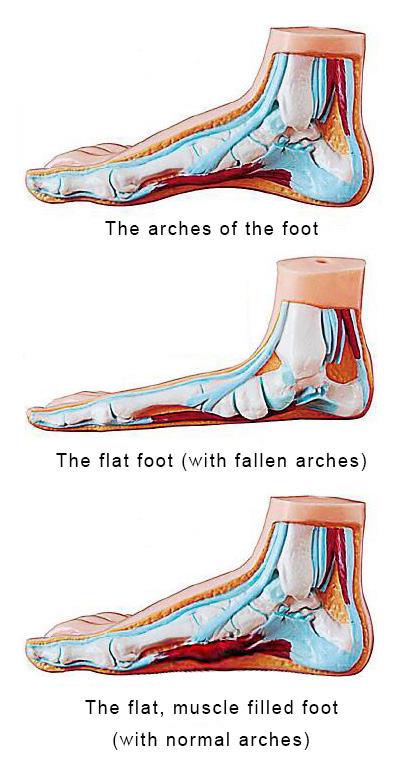The Structure of Flat, Muscles Filled Feet |
|||||||||||||||||||||||||||||||||||||||||||||||||||||||||||||||||
|
The characteristics of human hands and feet vary with the evolution of the human line. Humans at early stages had to use their hands and feet to climb the tree to adapt to life in the forest. And in order to swing the body between branches, they needed to have long and strong fingers, toes, and forearms. Prehistoric people had long and flexible fingers and toes, so they could use tools and walk upright. Modern humans have nimble fingers and arches of the foot. Nimble fingers enable humans to use hands and the brain in combination. The arches of the foot are a three-point support structure formed by the first and the fifth metatarsal bones and the calcaneous. They allow the foot to support the weight of the body, provide appropriate resilience and torsion, and absorb the ground reaction force when the body is walking or running. They assist the body to complete movements, like standing, walking and running. However, without the protection of flat muscles filling up the space among the arches, when the foot contacts the ground, the ground contact reaction force will directly reflect in the form of resonance waves, stimulating the cerebral cortex with nerve impulse, which inactivates the transmission across synaptic clefts and affects the performance of the brain in executing calculation and memorization functions that require ultra-high precision and high accuracy. In addition, on the flat and smooth surface of the ground made of tiles, marble, granite, etc., the arches of the foot are susceptible to sliding, falling and injury. Flat feet whose arches are too small or which have no arches lack resilience and will therefore feel rather struggling in jumping and running and easily get fatigued in walking. The first major biological characteristic of the Bodhi humans is the structure of Flat, Muscles Filled Feet. In addition to support the body weight with the three-point structure formed by the arches, the flat muscles filling up the space among the arches can buffer or offset the ground reaction force generated when the feet contact the ground, preventing the brain from being agitated by the reflection waves elicited from the motor nerves of the feet. This biological characteristic mainly serves to protect the Usnisa Cortex specific to the Bodhi humans, allowing them to perform the resonance, scanning, remote transmitting, remote sensing functions, etc., under heavy exercise. Moreover, when the feet contact the flat and smooth surface of the ground, the flat muscles that fill up the space among the arches can closely adhere to the ground to avoid sliding, falling and injury.
The structure of the Flat, Muscles Filled Feet of the Bodhi humans not only satisfactorily solves the problem of inactivated transmission across synaptic clefts due to the agitation of the brain triggered by the reflection waves from the feet, but also means the beginning of humans proceeding toward a brand-new stage of evolution. This structure of Flat, Muscles Filled Feet together with the Usnisa Cortex are both listed as the major attributes in the 32 biological characteristics of the Bodhi humans. The structure of the Flat, Muscles Filled Feet of the New Human Line is different from that of flat feet.
The following photo shows the Flat, Muscles Filled Feet of Mr. Yuan Lin, the first New Human Line, the Bodhi humans, who has successfully evolved from Homo sapiens.
The structure of the Flat, Muscles Filled Feet of the New Human Line, the Bodhi humans, can be inherited by the next generation.
|
|||||||||||||||||||||||||||||||||||||||||||||||||||||||||||||||||
|
|||||||||||||||||||||||||||||||||||||||||||||||||||||||||||||||||



